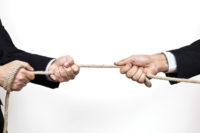“Ah Joe, it’s one of those iPod music things. My wife got it from her company. It was some kinda safety gift.â€
Joe wanted to know more. “What’d she have to do to get it?â€
“Don’t know. She couldn’t tell me.â€
Joe smiled and shook his head. Funny how organizations go through some of the same challenges with their incentive programs. Often workers don’t know how the gifts relate to safety goals or types of safety improvements.
Icing on the cake
“You know Willie, we’ve used incentives to improve awareness and help people to work safer for a number of years. We think it helps. I guess we’ve tried all kinds of stuff — point systems with gift catalogs, hats, jackets, individual incentives, team incentives. You know what we’ve gone through.“We’re always trying to put a fresh twist into our programs, but it can be frustrating and time-consuming. What we really want to do is tie incentives to individual and team-related actions that make sense and help everyone work safer.â€
Willie looked up and listened to Joe. He liked the rewards he received from time to time, even though the meaning of some of the safety gifts was lost in the shuffle. And he wasn’t thinking, iPod Shuffle! Maybe there were just too many goals, objectives, and metrics that didn’t always make sense.
Willie also knew he worked in a very safe facility. Safety compliance training programs are always on schedule. He works with great equipment, tools and PPE. Leaders here really care. They have a good behavior-based safety (BBS) process. He also knew that incentives and recognition are just icing on the cake — reminders to bring some top of mind awareness for safety (TOMAS).
Words make a difference
Joe was getting on a roll about incentives and broke into Willie’s train of thought.“You know, one of the problems we’re discussing right now is the words we use to talk about our recognition programs. Both rewards and incentives are sometimes seen in negative ways. I know some of the guys think we’re trying to ‘bribe them’ into working safely.
“Yeah, I guess you could say it looked like a bribe when we had that lottery for the vacation to Hawaii, but that was more than five years ago. Our gifts back then were big and getting bigger. You remember, Willie. We kinda got caught up in it all and got carried away probably. All we really want is for everybody to work safer for themselves, their co-workers, and for their friends and families.â€
“So what do you mean you guys on the safety committee are thinking about the words you use to talk about incentives?†asked Willie. “What’s the big deal?â€
“How do you like the sound of ‘Safety R&Rs’? asked Joe. “See, we want to reward and recognize individual safety leaders, right on the floor. And we want to do the same for safety-related contributions teams make toward getting to zero incidents. We want safety on everybody’s minds all of the time — even at home. We want zero, Willie!â€
“I’m always ready for some R&R, Joe, so ‘Safety R&R’ has gotta be a good thing. Yeah, I can see what you’re saying. It’s important to put some meaning to those incentives.â€
Individual & team performance
“Incentives work for most people, Willie, we know that, but we want to make sure they continue to work,†explained Joe. “We need to keep the gifts small and make the recognition as personal as we can. And here’s the funny thing: even though some of the guys say they’re embarrassed when we recognize ’em in front of their friends, we know most of ’em are glowing inside. We hear it from their families. Our guys are proud about safety and they want to get more involved.â€â€œJoe, you can embarrass me anytime with one of those ‘Safety R&Rs’,†smiled Willie.
“Incentives are a good way to show we appreciate our safety leaders,†said Joe. “You know, for setting a great example and modeling the way, every day. For being a champion for safety!
“What’s become one of the most enjoyable safety moments for me is when our guys vote for the best safety leaders from their groups. People get pumped-up and proud about safety, and the recognition strengthens their resolve to want to do the right thing for safety’s sake. These guys are becoming more and more mindful of the example they set. It’s really important — and at times it takes some courage. That’s why they’re leaders.â€
“You’re right about that,†said Willie. “I know I’ll be plenty proud when I’m recognized some day. It’ll draw out other safety leaders, too. Besides, you can’t beat those barbeques. They bring us together in one place. I think it helps make us closer and puts us on the same page, working together to reach the same goals. We feel like a unit. A hungry unit, if you get what I mean.
“I see where you’re coming from, Joe — recognizing individuals helps strengthen our teams, and the team rewards help build up the individuals. It all works together.†A light bulb switched on in Willie’s head. “You know, when it comes to those team-related incentives, I mean those ‘R&Rs’, I think we can do a better job. We already have ergonomic and incident review teams, and different groups get recognized for their BBS scores when they’re over a certain level and they hold it there. But we have to make sure we keep the focus on actions, what people are doing every day, not just the final score.â€
Pushing the positive
Joe got a kick out of making Willie think long and hard about incentives. You need these kinds of conversations to make sure the organization doesn’t fall into a rut with its use of incentives. It’s easy for incentives to turn into entitlements; the guys get use to them and expect them and forget what’s behind them. You need supervisors and safety coaches like Joe talking straight about safety, no shuffling around, reminding the guys always what the vision really is — zero incidents and zero accidents.“Willie, in all of this, we believe we can create a more positive safety climate, more open communications and higher levels of trust. We want more awareness for everyone — TOMAS, remember? We want easy-to-understand safety goals, and we want to have FUN! If we have fun, we get more people involved and that means everybody contributes to our safety vision. Rewards and recognition programs can help pull this together.â€


